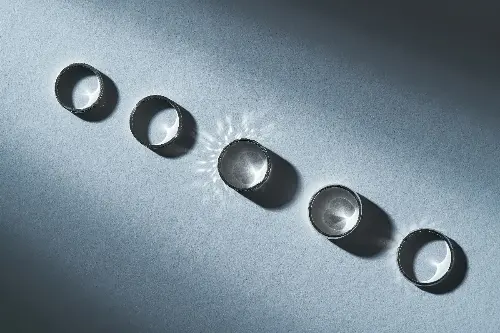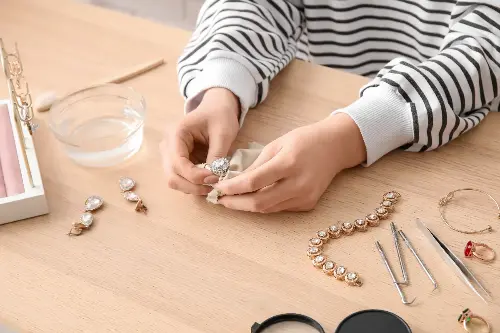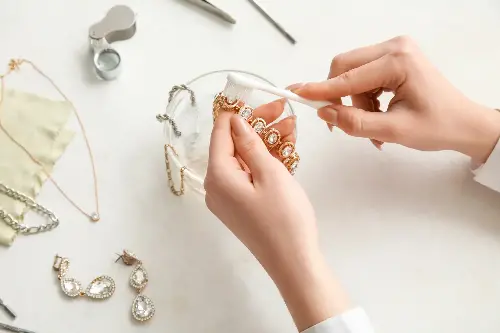Sterling silver jewellery has long been cherished for its lustrous beauty and timeless elegance. However, owing to its predisposition to tarnish – a natural reaction silver has with hydrogen sulphide in the air and the oils in our skin – it can lose its sparkle over time. Fortunately, there are some tried and tested methods to rejuvenate your beloved treasures. Among these, the humble toothbrush and the surprising use of tin foil have proven themselves as invaluable tools in the battle against tarnish.

The Science of Silver Tarnish
Understanding the enemy is the first step to combatting it. Tarnish on sterling silver is primarily caused by the chemical reactions between silver and non-metallic elements such as sulphur or oxygen. This often results in a yellowish or grey-black coat forming on the surface, obscuring the natural brilliance of your jewellery. While storing silver in airtight bags with anti-tarnish strips is effective in slowing down the process, cleaning it is inevitable.
The Role of Aluminium and Baking Soda
Before we delve into the detailed process of cleaning, let's explore the curious role of aluminium foil in restoring the shine to your silver pieces. A fascinating chemical reaction takes place when you place your tarnished silver in a solution of hot water, baking soda, and aluminium foil. The chemical reaction called an ion exchange allows for the tarnish to transfer from your silver to the aluminium foil, thus polishing the silver without abrading it.

Preparing for a Deep Clean
To begin the restoration process, it's important to collect all the necessary items:
- A toothbrush: preferably an old one with soft bristles to avoid scratching the silver.
- Baking soda: a natural and gentle abrasive.
- Aluminium foil: to line the cleaning container and facilitate the ion exchange.
- Hot water: to create an effective solution for the reaction.
- A soft cloth: for drying and buffing the jewellery.
- A bowl or dish: to create the cleaning solution.
The Tin Foil Technique: Step by Step
First, line a bowl or dish with a sheet of aluminium foil, making sure the shiny side is facing upward. Boil enough water to fill the container and submerge your silver pieces. While waiting for the water to boil, sprinkle a layer of baking soda over the foil – you'll need about one tablespoon for each cup of water.
Once the water has come to a boil, slowly pour it into the dish with the baking soda, then place your silver jewellery on top of the foil. Ensure each piece of jewellery is touching the aluminium. You should start to see some bubbling, and this is a sign that the tarnish is beginning to transfer from the silver to the foil.
Allow your silver pieces to soak in this solution for two to five minutes, depending on the severity of the tarnish. Afterward, carefully remove the pieces – they could be quite hot – and rinse under cool, running water. If there are any remaining spots of tarnish, you can now employ the toothbrush.

The Gentle Abrasion Method with a Toothbrush
Using a soft-bristled toothbrush allows you to get into the nooks and crannies of intricate silver jewellery that the foil method might miss. Wet the toothbrush, sprinkle a pinch of baking soda onto the bristles, and then gently scrub the tarnished areas. Work over the item methodically, ensuring you reach every crevice without using excessive force.
Once the toothbrush has done its job, rinse the item once more. If the tarnish persists, repeat the scrubbing process with extra care. The combination of soft bristles and baking soda should remove most tarnishing without damaging the jewellery.
Drying and Buffing for a Lasting Shine
After thoroughly rinsing your jewellery, instantly pat dry each piece with a soft, lint-free cloth. Leaving silver wet can lead to water stains, which are another form of tarnish. Once the pieces are dry, use another clean, dry cloth to buff the silver gently. Buffing not only dries the jewellery but also helps restore its original lustrous finish.
Frequent Care and Preventative Measures
In addition to these cleaning methods, regular care and preventative measures can keep your silver sparkling for longer. It's recommended to remove silver jewellery before swimming, showering, or engaging in any activities that could expose it to harsh chemicals or excessive moisture. Additionally, wearing your silver often can actually prevent tarnish due to the 'polishing' effect caused by friction with your skin and clothing.
Sterling silver jewellery embodies a perfect union of strength and splendor, a legacy of style that can truly stand the test of time. With these simple yet innovative cleaning methods – utilising a toothbrush and tin foil – you can maintain the radiance of your collection with ease and confidence. Not only will you save yourself a trip to the jeweller, but you'll also engage in the delightful ritual of caring for treasures that may one day become heirlooms. Keep the brilliance alive, and enjoy the continued compliments that come with beautifully maintained sterling silver jewellery.